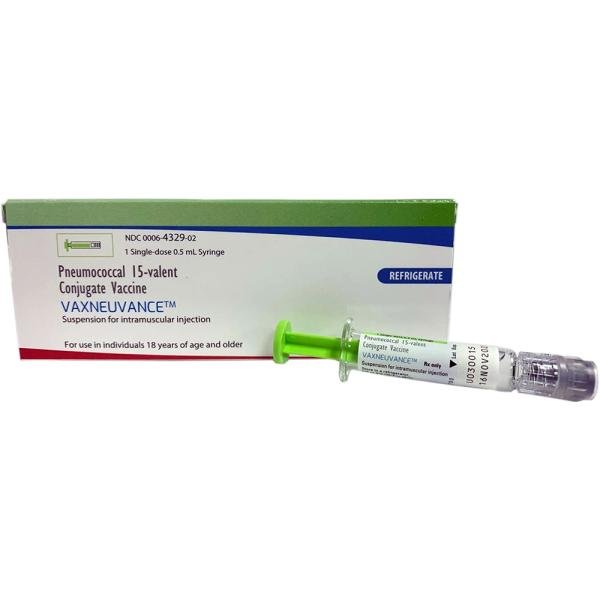Vaxneuvance
Generic name: pneumococcal 15-valent conjugate vaccine
Dosage form: injection
Drug class: Bacterial vaccines
What is Vaxneuvance?
- Vaxneuvance is a vaccine to help protect against invasive disease caused by 15 types of pneumococcus (pronounced “noomo-ca-cus”), a kind of bacteria. Invasive disease includes:
- an infection in the blood (bacteremia).
- an infection of the coverings of the brain and spinal cord (meningitis).
- Vaxneuvance is for individuals 6 weeks of age and older.
- Vaxneuvance will not give you disease caused by pneumococcus.
- Vaxneuvance might not protect everyone who gets the vaccine.
Who should not get Vaxneuvance?
Do not get Vaxneuvance if you or your child:
- have or had an allergic reaction to any of the ingredients in Vaxneuvance or to diphtheria toxoid. (See the list of ingredients at the end of this information sheet.)
Before receiving Vaxneuvance
Tell your healthcare provider if you or your child:
- have or had an allergic reaction to any vaccine.
- have a weak immune system (which means your body has a hard time fighting off infections).
- take medicines or treatments that might weaken your immune system (like immunosuppressants or steroids).
- are pregnant or planning to get pregnant.
- are breast-feeding.
How is Vaxneuvance given?
Vaxneuvance is given as an injection into the muscle (usually in your upper arm for adults and the upper arm or thigh for children).
Children need 4 doses of the vaccine:
- The first injection is given at 2 months old.
- The second injection is given at 4 months old.
- The third injection is given at 6 months old.
- The fourth injection is given at 12 through 15 months old.
If your child did not receive the complete series according to this schedule, your healthcare provider may suggest a catch-up schedule.
Your child may get Vaxneuvance at the same time they get other vaccines.
Adults need one dose of the vaccine.
Vaxneuvance side effects
The most common side effects in children less than 2 years of age include:
- Fever
- Pain, redness, swelling, or a lump where your child got the injection
- More fussy than usual • More sleepy than usual
- Eating less than usual
The most common side effects in children and adolescents 2 through 17 years of age include:
- Pain, swelling, redness or a lump where your child got the injection
- Muscle aches
- Feeling tired
- Headache
The most common side effects in adults 18 years of age and older include:
- Pain, swelling or redness where you got the injection
- Feeling tired
- Muscle aches
- Headache
- Joint pain
These side effects generally last three days or less.
If you or your child have any side effects that bother you or any other unusual symptoms that develop after you get this injection, tell your healthcare provider. Tell your healthcare provider right away if you or your child have symptoms of an allergic reaction which may include:
- Difficulty breathing
- Swelling of your face, lips, tongue or throat
- Hives
- Rash
There may be side effects that are not listed here. For more information, ask your healthcare provider.
You may also report any side effects to Merck Sharp & Dohme Corp., a subsidiary of Merck & Co., Inc., at 1-877-888-4231 or directly to Vaccine Adverse Event Reporting System (VAERS). The VAERS toll-free number is 1-800-822-7967 or report online to www.vaers.hhs.gov.
Related/similar drugs
What other drugs will affect Vaxneuvance?
Taking medicines that suppress your immune system (immunosuppressants) may reduce the immune response to this vaccine.
What are the ingredients in Vaxneuvance?
Active ingredient: Bacterial sugars from 15 types of pneumococcus each linked to a protein (CRM197). The sugars from these bacteria and the protein are not alive and do not cause disease.
Inactive ingredients: Sodium chloride, L-histidine, polysorbate 20 and aluminum (aluminum phosphate is included to help the vaccine work better).
Vaxneuvance does not have any preservatives.
The tip cap and plunger stopper of the prefilled syringe are not made with natural rubber latex.
What if I have other questions?
If you have additional questions, talk to your healthcare provider or call the Merck National Service Center at 1-800-622-4477.
Frequently asked questions
- Prevnar 20 vs Pneumovax 23: Which vaccine is right for you?
- How long does a pneumonia vaccine shot last?
More about Vaxneuvance (pneumococcal 15-valent conjugate vaccine)
- Check interactions
- Compare alternatives
- Pricing & coupons
- Drug images
- Side effects
- Dosage information
- During pregnancy
- FDA approval history
- Drug class: bacterial vaccines
- En español
Professional resources
Related treatment guides
Further information
Always consult your healthcare provider to ensure the information displayed on this page applies to your personal circumstances.

